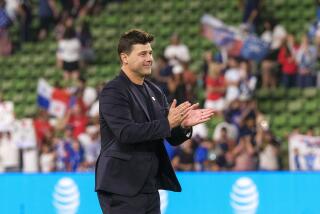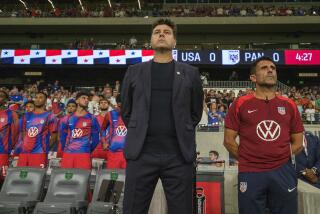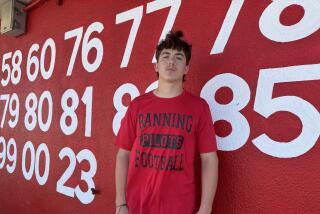A Homecoming for Perez at Midfield : Soccer: He leaves Saudi Arabia to rejoin the U.S. team and is counted on to stir up a stagnant attack.
A key piece of the puzzle is in place for the U.S. national soccer team, as it begins play today in the Kirin Cup tournament at Nagoya, Japan.
The addition is midfielder Hugo Perez, and his return does not complete the picture for the United States. But his creative play does help fill in at least one blank.
Perez will start today against Hungary in his first appearance with the team in nearly five months.
The United States has a 1-1-4 record but has failed to score much and has shown disarray in the middle of the field.
Perez, who has been playing professionally in Saudi Arabia, was released from his club last week so he could join the U.S. team. Coach Bora Milutinovic will get his first look at Perez in months and at the style of play that he so admires--highly stylish and creative.
“Bora has called Hugo the engine room, the player who’s making it happen,” said Bill Nuttall, general manager of the U.S. national team. “Right now, we’re lacking that. That’s no secret.”
Perez was born in El Salvador, grew up in Torrance and exemplifies what many refer to as a Latin style. He is highly skilled and not confined by static patterns. Some coaches view this freewheeling approach as a lack of discipline. Others, such as Milutinovic, see it as part of the game’s character.
In 47 full international matches with the U.S. team, Perez’s role has been that of a quarterback, directing the attack from the midfield. In his absence, that leadership has not gone to any one player. When Milutinovic asked Nuttall to seek Perez’s release for the Kirin Cup, it was part of his continuing search to find the right player to spark a lagging U.S. offense.
But if Milutinovic likes what he sees and asks Perez to join the national team in Mission Viejo, he won’t get his full-time services until August.
That’s because Saudi Arabia’s King Fahad saw Perez first and offered to pay him more. Perez was noticed during the Intercontinental Championships in Saudi Arabia last October and Ittihad Club in Jidda offered him $300,000 for the 10-month season, as well as free housing, a car and free education for his three children.
The offer was generous, but there were other considerations. American players, in ever greater numbers, are playing in European soccer leagues. But no one had yet played in the Middle East. Perez talked with his wife, thought for a moment, then agreed.
“I’m coming to the end of my career,” Perez said by phone from Jidda. “I wasn’t inclined to come here. I had already spent a couple of years in Europe. I thought that was enough. I wanted to stay at home with the national team.
“But there are a lot of conditions to playing with the national team. The salary is OK, but nothing like you can earn elsewhere. There is also a lack of freedom, with some clauses in the contract. I decided that the chance I had here to provide security for my family was too great to pass up.”
Perez, 29, has been playing professional soccer since he was 17, but has had a stormy relationship with the U.S Soccer Federation, particularly as it regards the World Cup.
He was one of the country’s brightest players in 1990 and thought to be an automatic choice for the World Cup team. He had been playing in France for second-division Red Star. Perez was recovering from a broken bone in his right ankle when, he says, the USSF asked him to come back to the United States for assessment by a team doctor.
Perez said that he was assured that, if he left his French team and was pronounced fit, he would be named to the World Cup team. Based on that promise, Perez left Red Star and his $140,000 contract.
He reported to a doctor in North Carolina, who said Perez would be healed in time for the World Cup.
But U.S. Coach Bob Gansler did not select Perez, saying he was injured. Perez, who had been nagged by injuries, had played in only five of 27 international matches from 1988 to 1990. About the same time Gansler was saying he was not fit, Perez was playing against European clubs Real Madrid and Cologne in the Coliseum.
Perez was replaced by collegiate player Neil Covone, who had a knee injury and didn’t play.
A few professional players were kept off the 1990 World Cup team, including Frank Klopas, who, like Perez, is in the player pool for 1994.
“It’s one thing for a doctor to clear a player, and it’s another for a player to be match fit,” Gansler said from Australia, where he is with the under-20 team at the World Championships.
Perez, who had been dreaming of playing in the World Cup since he was a youngster, was devastated at being left off the team.
“I was really down for a long time. I have to be honest,” he said. “The most awful day in my career was when (Gansler) told me he didn’t need me. Believe me, it hurt me. After all the years I had been with the federation, since age 18. I felt the way I was treated, it was just real bad. But it’s hard for me to judge and blame now, years later.”
Perez went to play in Sweden. Every time the national team called for him to join it, Perez hopped. He played in 11 games in 1991 and 17 last year.
Perez was U.S. soccer’s player of the year in 1991, but last year the USSF allowed his contract to expire so it could be renegotiated. Perez and the federation never agreed to terms, so when the Saudis called, Perez listened.
“I had a hard time deciding to come here,” he said. “I made the decision for my family and for myself. Since we don’t have a professional league in America, our only choice is to either play for the national team or play abroad. For a guy with a family, you can’t support them on that (U.S.) salary.
“I’ve been thinking about retiring. Not because I can’t play anymore, but because of all that’s happened and because I’ve gotten so much out of football.”
By playing in the Kirin Cup, Perez will be under the scrutiny of the U.S. coaching staff. They know what he’s capable of doing.
“One dimension that Hugo has is he can change the rhythm of the game,” said assistant coach Timo Liekoski. “He can head the ball and he can play with his feet. He dribbles well. He’s the type of player that we certainly could use.”
Perez said he tries not to think about the 1994 World Cup.
“I don’t think about it much, after what happened in 1990,” he said. “I know not to get my hopes high.”







